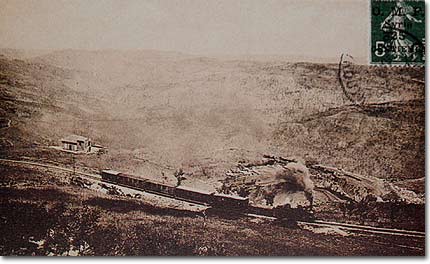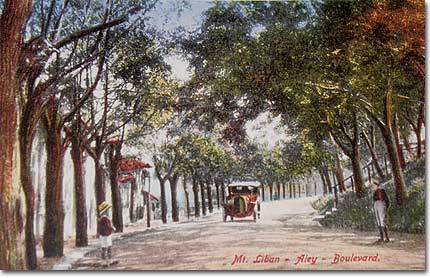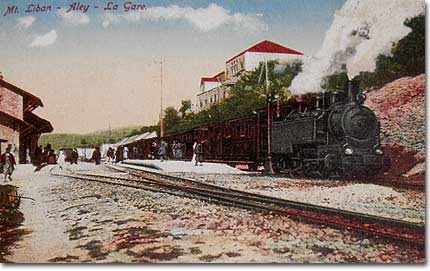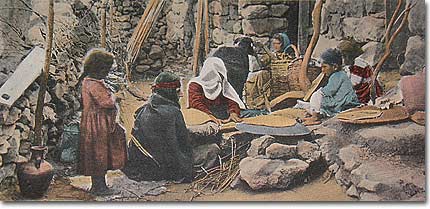Born in a family of Armenian Protestants, the three Sarrafian brothers, Abraham born in 1873, Boghos born in 1876 and Samuel born in 1884, came from Dikranagered.
After being pupils in the Armenian national primary school, Abraham and Boghos Sarrafian pursued their junior high school studies at the American High School at Mardin in Turkey. At the age of fourteen, Abraham studied science, Arabic, and English and obtained his diploma at the end of four years. As for Boghos, he pursued his junior high studies in English and Arabic.
While still only eighteen years old, Abraham Sarrafian was sent to teach at the American School at Mediet. One year later he returned to his hometown of Dikranagered to open a photographic laboratory there together with his brother Boghos, also spending a year in Berlin to gain more advanced experience.
In their enthusiasm for taking photographs, in 1894 the two brothers undertook an eight-month expedition in Mesopotamia, going as far as Mosul, where they took shots of the city’s ancient ruins. The vantage points chosen during their travels reflect their ability to adapt themselves to the discoveries made where they found themselves. Following the advice of their father, upon their return, they opened a shop selling antiques. The father Sarrafian, a banker by profession, was also a carpet merchant and was well-known as an antiquarian and numismatist.
Three months after their return to Dikranagered there occurred the tragic events of 1895 which were to mark the course of their respective lives. Saved in extremis during the massacres and pogroms, in 1897 the Sarrafian brothers decided to leave their country. They reached Beirut with the intention of carrying on to Europe. As they knew Arabic very well, certain Lebanese and Protestant missionaries urged Abraham and Boghos to settle in Beirut and bring their families. In 1896, Abraham Sarrafian had married Yeranig Garabedian, daughter of the head of the Armenian Episcopal Church in Dikranagered, educated first in the English School of Jaffa and then at the school in Mardin. The youngest brother, Samuel, was thus enabled to enter the American University and obtain a diploma in Business Administration.
Thanks to their honesty, intelligence and ability and the energy they put into their work, they enjoyed considerable success. In the early twentieth century, photography was an art which allowed reality, at last, to be shown without the changes and whims to be revealed in paintings. Crisscrossing the Near and the Middle East, they took photographs of various archeological sites and famous monuments in Lebanon and Syria and little by little made themselves known in the region. In 1895 they set up their studio in the Bab Idriss sector of Beirut, a studio which remained active long after the decease of the Sarrafian brothers, in fact up to 1975, the beginning of the Lebanese War.
As founders of the company Sarrafian Brothers, their main activity was photography and production of postcards. They soon enlarged their business, opening new branches in towns in Syria and even in Palestine. The fame of their establishments and of their work went from strength to strength down the years. In this way, the Sarrafian brothers rapidly became known as the main publishers of postcards in the Near East, and after becoming official photographer of the Syrian Protestant College (future American University of Beirut), Abraham Sarrafian in 1925 won the first prize of photography at Dhour es-Shweir. Samuel Sarrafian was charged in the company with the sale of the postcards and objects of art.
In its unceasing efforts to understand and reveal the traditional Lebanese culture and way of life, the company Sarrafian Bros. has with great fidelity photographed and passed on the traditions of the villages with their customs and costumes. Its output of postcards has been immense and these photographs are now a source of reference for historians and anthropologies wishing to study the period.
The First World War brought down on Lebanon a whole series of disasters; first of all, there was the blockade imposed by the Ottoman authorities, which reduced the population by a third, due to famine, the plague and an invasion of locusts. During this time the Armenians were victims of harsh persecutions, a large number of them being sent out into the deserts of Deir ez-Zor, Madn and Kirkuk to be tortured and massacred there. The Sarrafian brothers set an example of action and devotion in bringing help not only to their compatriots but also to other victims of this time of drama marking the history of the region.
Abraham Sarrafian became the father of five children, two boys Tigran and Levan, and three daughters Araxie, Armine and Any. He was an episcopal councilor and the first representative of the Evangelical community. From 1920, with the large-scale arrival in Beirut of Armenians who could speak only Turkish, the sermons previously delivered in Turkish were henceforth given in Armenian thanks to the efforts of Abraham Sarrafian. As Beirut was a major port, many survivors from the deserts arrived in a state of destitution, half-naked, hungry and exhausted. So Abraham Sarrafian put aside his work and his family affairs in order to come wholeheartedly to the aid of his compatriots. The more his people suffered, the more he showed his sympathy for them, laboring and devoting himself. He did much to help the thousands of individuals pouring in from Cilicia and Syria especially into Beirut and he was helped in this by other open-hearted Armenians such as Doctor Melkonian. His position as President of the National Union, of the General Union of Armenian Charities and of the Administrative Council of the Aintab Orphanage, as well as of Administrator of the Kaledjian Orphanage enabled him to do more. With his wise advice he also helped the Secours du Proche-Orient and by his good relations with the members of the government, he was able to achieve much.
Boghos Sarafian married Anna Tufekjian, became the father of a daughter Toukhie and of two sons, George and Yervant and was an eminent nationalist. Thanks to his friendships and contacts with the press, he was able to send large quantities of wheat and flour to the Armenian monastery of Bzommar, where the desperate monks sheltered many refugees, who were thus saved from certain death. Most notably, he came to the aid of three who were condemned to death, Osken Bedrossian and two Muslim Arabs, who had fled from having to do military service. They have freed thanks to the intervention of Boghos Sarrafian. His wife Anne also was a true Armenian patriot, taking part alongside her husband in his national activity.
Like his two brothers, Samuel Sarrafian proved to be a person free from personal interest, tirelessly devoted to his motherland. He married Zabel Agemian, having a son Karnig and three daughters Satenig, Anahid and Sona. Among other patriotic activities, Samuel Sarrafian helped Catholicos Sahag to set up the Holy See of Cilicia in Antelias. With this in view, Samuel with the help of his brothers sought free possession of some land belonging to Secours du Proche-Orient at Antelias. Their efforts were rewarded and Antelias is now the seat of the Armenian Catholicos of Cilicia.
Abraham Sarrafian died of a heart attack on 16th June 1926 when he was 56 years old. A number of Armenian and other local publications paid him tribute. The Headmaster of Broumana High School, Mr. M.N. Fox, wrote: “... persona grata among men of different culture. This deeply religious man preached in both English and Armenian. As an antiquarian he possessed articles of great value, knowing the history of everyone and loving to bring his friends to examine the precious stones, the National Museum or even the archeological sites. As a philanthropist he helped his people beyond his means, sharing their anguish and their suffering.” Boghos Sarrafian died on 11th August 1934 and was buried with great pomp. Samuel Sarrafian died in Beirut in 1941, As well as their contribution in the field of art, the brothers Abraham, Boghos and Samuel Sarrafian played a major role within the Armenian community in Lebanon, helping many Armenians during the course of the First World War.
The shots that the Sarrafian brothers took over more than thirty years remain still a unique record of Beirut, of its history and of its population. But the activity of the Sarrafian brothers was not limited to Lebanon. They crisscrossed the Near and Middle East.
Today their descendants are scattered around the world, but in Lebanon, while we find here Buhairys, Kurbans, Tahans, Faddouls, Nouns, Papazians, Nehmehs, Tcheblakians, Ogden-Smiths and Tabets, there are no more Sarrafians among the rising generations!
Extract of the Book "Sarrafian - Liban 1900 - 1930"

Mont Liban - Mount Lebanon, Vallée d'Ain Sofar - Ain Sofar Valley

Mont Liban - Mount Lebanon, Aley Boulevard

Mont Liban - Mount Lebanon, Aley La Gare

Baking in Lebanon - Préparation du Pain